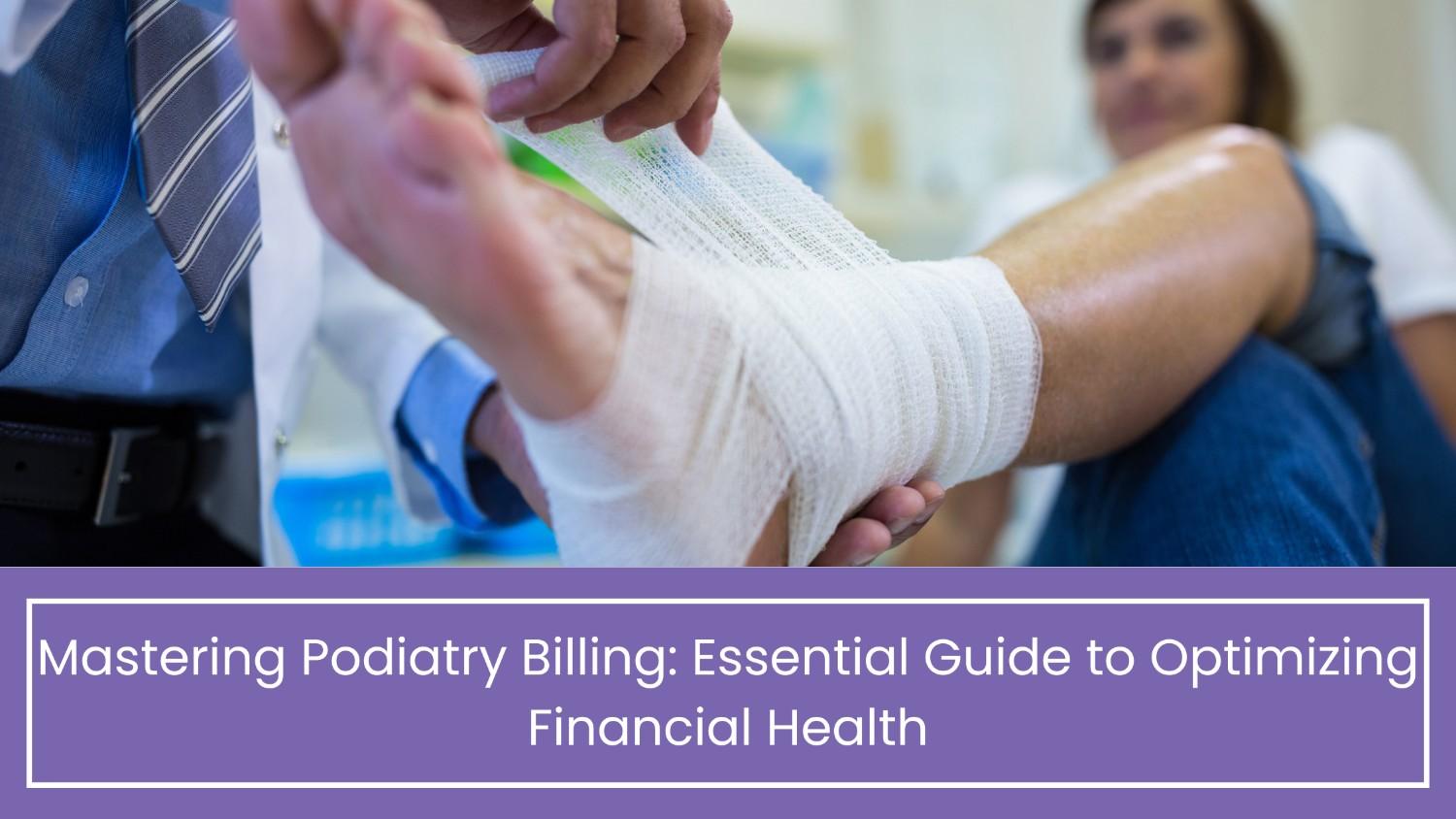Mastering Podiatry Billing: Essential Guide to Optimizing Financial Health
In the field of healthcare, podiatry is an important component in ensuring individuals’ overall well-being. As healthcare practices evolve, so do the administrative and financial aspects that undergo transformation. Podiatry, which focuses on the diagnosis as well as treatment of foot, ankle, and lower extremity disorders, necessitates specialized attention not just in clinical practice but also in billing along with revenue cycle management.
This comprehensive blog aims to shed light on the fundamentals of podiatry billing services, catering specifically to practices and healthcare professionals navigating the intricate world of foot care. From the basics of what podiatry billing entails to its pivotal role in the financial health of a practice, we will look into the details that make podiatry medical billing a unique and crucial aspect of modern healthcare administration.
Table of Contents
What Exactly is Podiatry Billing?
The process of managing and processing financial transactions related to podiatric medical services is known as podiatry billing. Podiatrists are experts in the diagnosis as well as treatment of ankle and foot conditions, so their billing procedures are unique in their field. This includes accurately documenting patient encounters, filing claims with insurance companies, and ensuring proper reimbursement for services rendered.
Podiatry billing includes the generation of detailed invoices that outline the specific services provided, such as examinations, surgeries, orthotic fittings, and other foot and ankle treatments. These invoices are then submitted to insurance companies for reimbursement. Additionally, podiatrists may bill patients directly for uncovered services or co-payments.
Given the complex nature of healthcare billing, podiatry billing and coding necessitates an in-depth knowledge of podiatry medical coding, insurance coverage, and regulatory guidelines. Podiatrists must adhere to specific coding systems, such as the Current Procedural Terminology (CPT) and the International Classification of Diseases (ICD), to accurately describe the services performed. Compliance with these coding standards is essential to prevent billing errors and ensure timely payments.
Efficient podiatry billing enhances the overall operational efficiency of a practice, streamlining the revenue cycle and minimizing financial disruptions. This process involves not only submitting claims but also managing patient billing inquiries, processing payments, and navigating the complexities of insurance negotiations. Utilizing Electronic Health Records (EHR) and Practice Management Systems (PMS) can further optimize podiatry billing, improving accuracy, reducing administrative overhead, and enhancing overall patient care.
Importance of Accurate Podiatry Billing
Accurate podiatry billing is crucial for various reasons, as it plays a vital role in the healthcare industry. Podiatry, focusing on the treatment of foot and ankle conditions, demands precise billing practices to ensure financial stability, regulatory compliance, and optimal patient care. Below are five key points highlighting the significance of accurate podiatry medical billing:
1. Financial Viability and Revenue Cycle Management
Accurate podiatry billing and coding are essential for the financial health of podiatry practices. Proper coding and billing processes facilitate timely reimbursement from insurance providers and reduce the risk of claim denials. This, in turn, ensures a consistent cash flow, allowing podiatrists to cover operational expenses, invest in technology, and deliver quality patient care. Efficient revenue cycle management through accurate billing contributes to the overall financial viability of podiatry practices.
2. Regulatory Compliance and Penalties Prevention
Podiatry billing must adhere to various healthcare regulations and coding standards set by government agencies such as the Centers for Medicare & Medicaid Services (CMS). Failure to comply with these regulations can result in severe penalties, fines, or even legal consequences. Accurate coding guarantees that podiatry practices remain in compliance with the most recent coding guidelines as well as regulations, lowering the risk of audits and penalties.
3. Enhanced Patient Experience
Accurate billing practices contribute to an improved patient experience. Patients are less likely to encounter billing errors or face unexpected financial burdens when the billing process is precise and transparent. Clear communication about charges, co-pays, and insurance coverage helps build trust between patients and podiatry practices. A positive patient experience not only fosters patient satisfaction but also encourages repeat visits and referrals, benefiting the overall growth of the podiatry practice.
4. Efficient Claims Processing and Reduced Denials
Proper podiatry billing involves accurate documentation and coding of services rendered. Clear and comprehensive documentation supports efficient claims processing, reducing the likelihood of claim denials. Denied claims can lead to delays in reimbursement and increased administrative burdens. Accurate billing practices help simplify the claims process, making sure claims are processed quickly and payments are received on time.
5. Data Accuracy for Informed Decision-Making
Accurate podiatry billing generates reliable data that can be utilized for informed decision-making. Analyzing billing data provides insights into the financial performance of the podiatry practice, helping practitioners make strategic decisions to enhance efficiency and profitability. Accurate data also helps in determining trends, assessing the efficacy of treatment modalities, as well as adjusting business strategies to meet the changing needs of the patient population.
Furthermore, accurate billing contributes to data integrity and analytics within the healthcare ecosystem. Reliable billing data serves as a valuable resource for researchers, policymakers, and healthcare administrators, enabling them to analyze trends, allocate resources efficiently, and make informed decisions. The accuracy of billing data is becoming increasingly important in the age of value-based care, where medical reimbursement is linked to the standard and outcomes of services provided. Precise billing data is instrumental in demonstrating the value of podiatric care and its impact on patient outcomes.
Key Components of Podiatry Billing
To understand podiatry medical billing fully, it’s essential to break down its key components. These components encompass various stages of the revenue cycle, starting from patient registration to claim submission, payment posting, and denial management.
- Patient Registration and Eligibility Verification: The first step in podiatry billing involves accurately capturing patient information and verifying their insurance eligibility. This ensures that the practice has the necessary details to initiate the billing process and that the services rendered are covered by the patient’s insurance.
- Coding and Documentation: Podiatry services require meticulous podiatry medical coding and documentation. Podiatrists must use specific codes from the podiatry CPT and ICD to accurately represent the diagnosis and treatment provided. Accurate podiatry coding is the foundation of successful podiatry billing.
- Claim Submission: Once services have been coded and documented, the next stage is to submit claims to insurers. To avoid claim rejections, this process necessitates meeting submission deadlines, adhering to payer-specific requirements, and paying close attention to detail.
- Payment Posting: Upon receiving payments from insurance providers, the amounts must be accurately posted to the patient’s account. This step involves reconciling payments against billed amounts and identifying any discrepancies that may require further attention.
- Denial Management: Denials are an unavoidable part of the billing process. Effective denial management entails determining the reasons for denials, appealing when necessary, as well as implementing corrective measures in place to reduce future denials.
In conclusion, the importance of podiatry billing services cannot be overstated in the dynamic landscape of healthcare. These specialized services contribute significantly to the financial viability, compliance, and overall efficiency of podiatric practices. From accurate podiatry coding to navigating the complex web of insurance claims, podiatry billing services serve as a crucial bridge between healthcare professionals and financial stability.
As podiatric practices continue to evolve, embracing specialized billing services becomes increasingly important. By outsourcing billing services, podiatrists can not only enhance their financial well-being but also redirect their focus towards providing exceptional patient care, ultimately fostering a healthier and more resilient healthcare ecosystem.
At Practolytics, we understand the unique needs of podiatric practices. Our comprehensive Revenue Cycle Management (RCM) services include specialized Podiatry medical billing services, ensuring accurate and timely reimbursement. Partnering with us enables podiatric practices to thrive in the evolving healthcare landscape, achieving both financial success and delivering outstanding patient care.
ALSO READ – Revenue Cycle Management: Where Financial Success Meets Healthcare in 2024
Talk to Medical Billing Expert Today — Get a Free Demo Now!






